Working with ColorPickerPalette in WPF
18 Feb 202524 minutes to read
This section explains the different types of colors available in the ColorPickerPalette and how to choose the colors and its panel customizations.
Accessing a Color programmatically
We can get or change the selected color of the ColorPickerPalette programmatically by setting the value to the Color property. If we want know the selected color name, use the ColorName property that holds the name of the selected color item. The default value of Color and ColorName property is Black and Color.
<syncfusion:ColorPickerPalette Color="Red"
Name="colorPickerPalette"
Width="60"
Height="40">
</syncfusion:ColorPickerPalette>ColorPickerPalette colorPickerPalette = new ColorPickerPalette();
colorPickerPalette.Color = Colors.Red;
colorPickerPalette.Width = 60;
colorPickerPalette.Height = 40;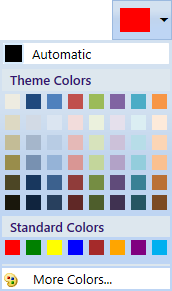
Here, Red color is selected color in the ColorPickerPalette.
NOTE
Accessing a color brush programmatically
You can get or change the selected brush of the ColorPickerPalette programmatically by setting the value to the SelectedBrush property. The default value of SelectedBrush property is Black.
<syncfusion:ColorPickerPalette SelectedBrush="Yellow"
Name="colorPickerPalette"/>colorPickerPalette.SelectedBrush = Brushes.Yellow;
Here, Yellow color brush is selected in the ColorPickerPalette.
NOTE
Setting automatic color
If we want to change the default selected color on application launching, set the value for AutomaticColor property. If we changed the selected color, then we can easily make the default color as selected color by clicking the automatic color panel. We can hide the automatic color visibility by setting the AutomaticColorVisibility property value as Collapsed. The default value of AutomaticColor property is Black and the default value of AutomaticColorVisibility property is Visible.
<syncfusion:ColorPickerPalette AutomaticColor="Green"
AutomaticColorVisibility="Visible"
Name="colorPickerPalette"
Width="60"
Height="40">
</syncfusion:ColorPickerPalette>ColorPickerPalette colorPickerPalette = new ColorPickerPalette();
colorPickerPalette.AutomaticColor = Colors.Green;
colorPickerPalette.AutomaticColorVisibility= Visibility.Visible;
colorPickerPalette.Width = 60;
colorPickerPalette.Height = 40;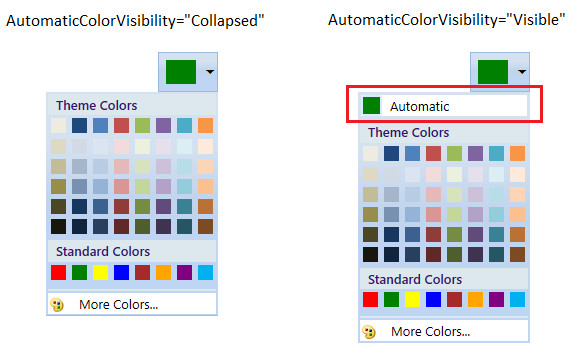
NOTE
Select transparent color programmatically
You can set a transparent color as selected color programmatically by setting the color code #00000000 or Colors.Transparent for Color property to indicate the null value.
<syncfusion:ColorPickerPalette Color="Transparent"
Name="colorPickerPalette"/>ColorPickerPalette colorPickerPalette = new ColorPickerPalette();
colorPickerPalette.Color = Colors.Transparent;
Select a predefined colors
We can select a color from either various theme color items or standard color items. We can show or hide the color items panel visibilities.
Select a color from theme color items
We can select a various theme colors by setting the value for Themes property. Based on the Themes value, the respective base color items are displayed with its variants. If we want allow the user to select only base theme colors without its variants color, use the GenerateThemeVariants property as false. We can hide the theme color panel by setting the ThemePanelVisibility property value as Collapsed. The default value of Themes property is Office and default value of ThemePanelVisibility property is Visible.
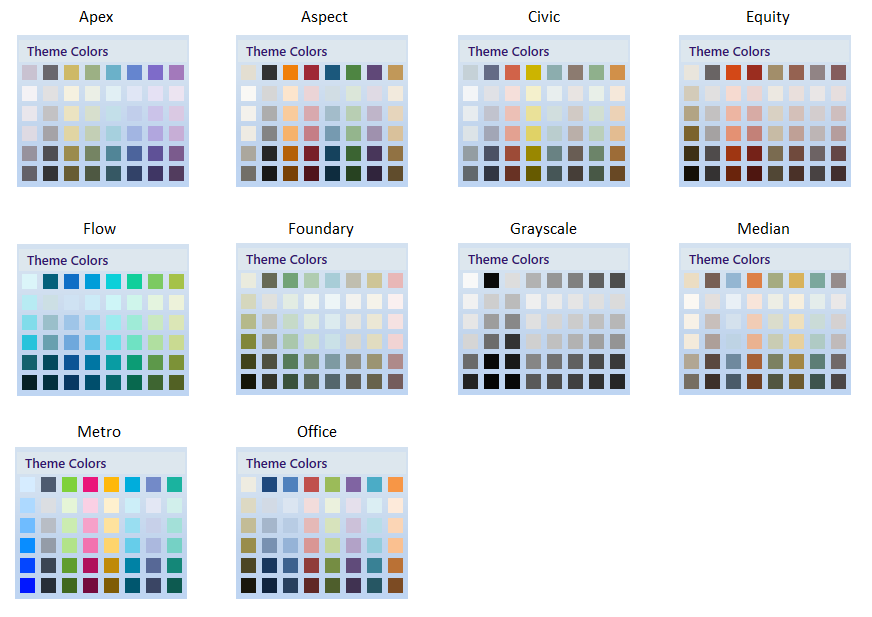
<syncfusion:ColorPickerPalette Themes="Metro"
GenerateThemeVariants="True"
ThemePanelVisibility="Visible"
Name="colorPickerPalette"
Width="60"
Height="40">
</syncfusion:ColorPickerPalette>ColorPickerPalette colorPickerPalette = new ColorPickerPalette();
colorPickerPalette.Themes = PaletteTheme.Metro;
colorPickerPalette.GenerateThemeVariants = true;
colorPickerPalette.ThemePanelVisibility = Visibility.Visible;
colorPickerPalette.Width = 60;
colorPickerPalette.Height = 40;
Select a color from standard color items
We can select a standard colors from the standard color panel. If we want allow the user to select standard colors with its variant colors, use the GenerateStandardVariants property as true. We can hide the standard color panel by setting the StandardPanelVisibility property value as Collapsed. The default value of GenerateStandardVariants property is false and default value of StandardPanelVisibility property is Visible.
<syncfusion:ColorPickerPalette GenerateStandardVariants="True"
StandardPanelVisibility="Visible"
Name="colorPickerPalette"
Width="60"
Height="40">
</syncfusion:ColorPickerPalette>ColorPickerPalette colorPickerPalette = new ColorPickerPalette();
colorPickerPalette.GenerateStandardVariants = true;
colorPickerPalette.StandardPanelVisibility = Visibility.Visible;
colorPickerPalette.Width = 60;
colorPickerPalette.Height = 40;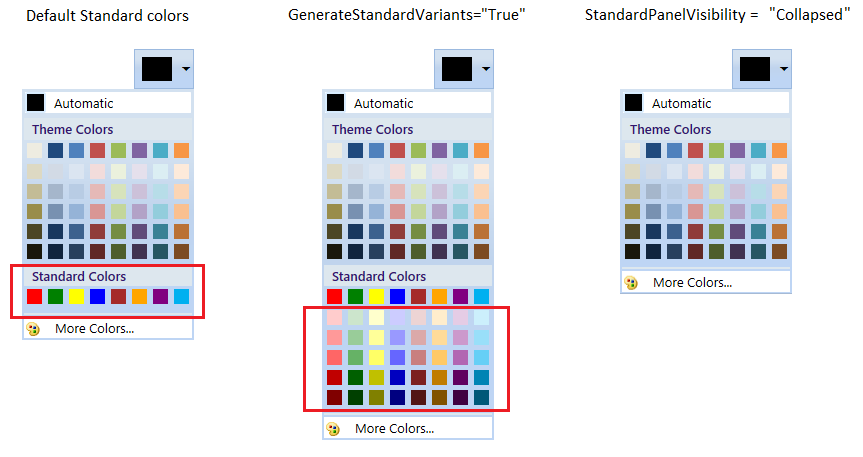
Show white and black color variants
If we want to allow the user to select the theme color from white or black or both color variants, use the BlackWhiteVisibility property as White or Black or Both. The default value of BlackWhiteVisibility property is None.
<syncfusion:ColorPickerPalette BlackWhiteVisibility="Both"
Name="colorPickerPalette"
Width="60"
Height="40">
</syncfusion:ColorPickerPalette>ColorPickerPalette colorPickerPalette = new ColorPickerPalette();
colorPickerPalette.BlackWhiteVisibility = BlackWhiteVisible.Both;
colorPickerPalette.Width = 60;
colorPickerPalette.Height = 40;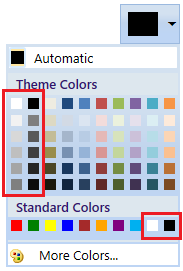
Add your own colors in the palette
If we want to allow the user to select a color from own colors, add that color with its name using CustomColor.ColorName and CustomColor.Color into the CustomColorsCollection and set the SetCustomColors property value as true. The provided CustomColor.ColorName is shown in the tooltip while mouse hovering on the color item. We can change the custom color panel header text and its visibility by using the CustomHeaderText and CustomHeaderVisibility properties. The default value of CustomHeaderText is CustomColors and default value of CustomHeaderVisibility is Visible.
public class ViewModel : NotificationObject {
private ObservableCollection<CustomColor> newColorCollection;
public ObservableCollection<CustomColor> NewColorCollection {
get {
return newColorCollection;
}
set {
newColorCollection = value;
this.RaisePropertyChanged("NewColorCollection");
}
}
public ViewModel() {
NewColorCollection = new ObservableCollection<CustomColor>();
}
}<Window.Resources>
<local:ViewModel x:Key="viewModel">
<local:ViewModel.NewColorCollection>
<!-- Defining the color details -->
<syncfusion:CustomColor Color="#FF11EBF8" ColorName="Aqua" />
<syncfusion:CustomColor Color="#FFF80FA6" ColorName="Deep Pink" />
<syncfusion:CustomColor Color="#FF8BA7C2" ColorName="Dark Gray" />
<syncfusion:CustomColor Color="#F53CDF07" ColorName="Lime Green" />
<syncfusion:CustomColor Color="#C2929545" ColorName="Olive Drab" />
<syncfusion:CustomColor Color="#2E956145" ColorName="Sienna" />
<syncfusion:CustomColor Color="#78458E95" ColorName="Steel Blue" />
<syncfusion:CustomColor Color="#8B8220E4" ColorName="Blue Violet" />
</local:ViewModel.NewColorCollection>
</local:ViewModel>
</Window.Resources>
<syncfusion:ColorPickerPalette CustomColorsCollection="{Binding NewColorCollection}"
CustomHeaderText="New Colors"
CustomHeaderVisibility="Visible"
SetCustomColors="True"
DataContext="{StaticResource viewModel}"
Name="colorPickerPalette"
Width="60"
Height="40">
</syncfusion:ColorPickerPalette>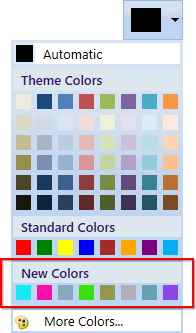
Click here to download the sample that showcases how to add your own color items into the palette.
Recently used color items
The recently selected color items are displayed in the RecentlyUsedPanel. If we want to choose a color which are previously selected, use the RecentlyUsedPanel. We can hide the RecentlyUsedPanel by using the RecentlyUsedPanelVisibility property value as Collapsed. The default value of RecentlyUsedPanelVisibility property is Visible.
<syncfusion:ColorPickerPalette RecentlyUsedPanelVisibility="Visible"
Name="colorPickerPalette"
Width="60"
Height="40">
</syncfusion:ColorPickerPalette>ColorPickerPalette colorPickerPalette = new ColorPickerPalette();
colorPickerPalette.RecentlyUsedPanelVisibility = Visibility.Visible;
colorPickerPalette.Width = 60;
colorPickerPalette.Height = 40;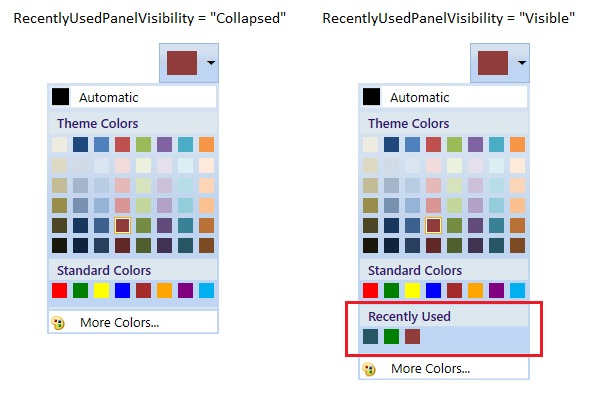
Choosing a color from MoreColor window
In addition to colors in Theme colors and Standard colors, MoreColor feature allows you to select wide range of color options. MoreColor feature includes two categories namely Standard Colors and Custom Colors. We can hide the visibility of the MoreColor Option by using the MoreColorOptionVisibility property value as Collapsed.

Selecting more standard colors
We can select color from 140 standard colors clustered in the shape of a Hexagon. If we want to hide the Standard color tab, use the IsStandardTabVisible property value as Collapsed. The color chosen from this cluster will also be added in the RecentlyUsedPanel.
<syncfusion:ColorPickerPalette IsStandardTabVisible="Visible"
Name="colorPickerPalette"
Width="60"
Height="40">
</syncfusion:ColorPickerPalette>ColorPickerPalette colorPickerPalette = new ColorPickerPalette();
colorPickerPalette.IsStandardTabVisible = Visibility.Visible;
colorPickerPalette.Width = 60;
colorPickerPalette.Height = 40;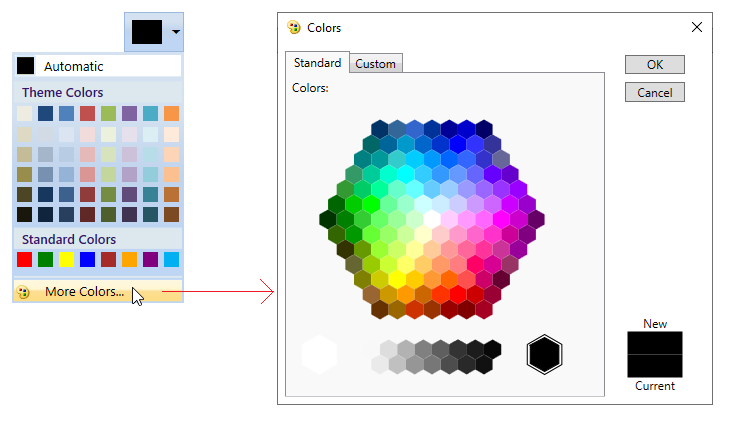
Selecting more custom colors
We can select any color and adjusting its saturation level by using the custom tab color picker . If we want to hide the custom color tab, use the IsCustomTabVisible property value as Collapsed. The color chosen from custom color picker will also be added in the RecentlyUsedPanel.
<syncfusion:ColorPickerPalette IsCustomTabVisible="Visible"
Name="colorPickerPalette"
Width="60"
Height="40">
</syncfusion:ColorPickerPalette>ColorPickerPalette colorPickerPalette = new ColorPickerPalette();
colorPickerPalette.IsCustomTabVisible = Visibility.Visible;
colorPickerPalette.Width = 60;
colorPickerPalette.Height = 40;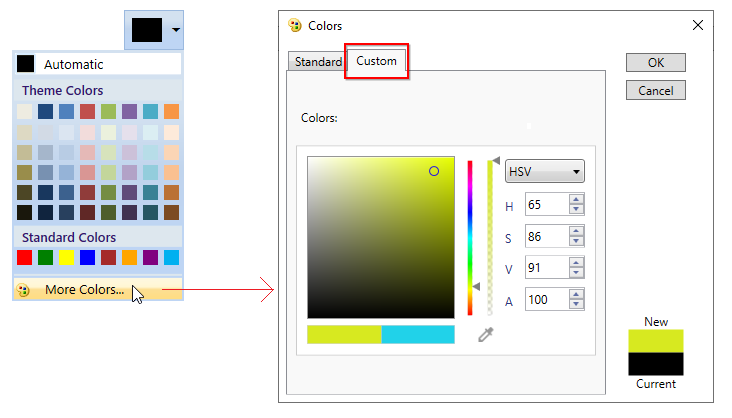
NOTE
If we set
IsCustomTabVisibleandIsStandardTabVisibleproperty value asfalse, then MoreColor option automatically hides.
Clear the colour you picked with a transparent colour
If you want to clear the selected color with a Transparent color, click the No Color button. You will be display the No color button only by setting the NoColorVisibility property value as Visible. The default value of NoColorVisibility property is Collapsed.
<syncfusion:ColorPickerPalette NoColorVisibility="Visible"
Name="colorPickerPalette"/>colorPickerPalette.NoColorVisibility = Visibility.Visible;
NOTE
Selected brush or color changed notification
The selected brush or color changed in ColorPickerPalette can be examined using SelectedBrushChanged event. The SelectedBrushChangedEventArgs contains the old and newly selected brush and its color values in the OldBrush,NewBrush and OldColor, NewColor properties. You can also get the selected brush and color changed notification by using the SelectedCommand property.
<syncfusion:ColorPickerPalette SelectedBrushChanged="ColorPickerPalette_SelectedBrushChanged"
Name="ColorPickerPalette"
Width="60"
Height="40">
</syncfusion:ColorPickerPalette>ColorPickerPalette colorPickerPalette = new ColorPickerPalette();
colorPickerPalette.SelectedBrushChanged += ColorPickerPalette_SelectedBrushChanged;
colorPickerPalette.Width = 60;
colorPickerPalette.Height = 40;//Invoked when the selected color or brush is changed
private void ColorPickerPalette_SelectedBrushChanged(object sender, SelectedBrushChangedEventArgs e) {
//Old and newly selected brushes
var OldBrush = e.OldBrush ;
var newBrush = e.NewBrush;
//Old and newly selected colors
var oldColor = e.OldColor;
var newColor = e.NewColor;
}Customize the header
You can customize the appearance of the ColorPickerPalette header and can display the selected color name in the header by using the HeaderTemplate property.
NOTE
The
DataContextofHeaderTemplateisColorPickerPalette
<Window.Resources>
<DataTemplate x:Key="Custom_HeaderTemplate">
<Grid>
<Grid.ColumnDefinitions>
<ColumnDefinition Width="auto"/>
<ColumnDefinition Width="auto"/>
</Grid.ColumnDefinitions>
<Grid x:Name="IconGrid"
Margin="2">
<Grid.RowDefinitions>
<RowDefinition Height="Auto"/>
<RowDefinition Height="*"/>
</Grid.RowDefinitions>
<Image x:Name="image"
Source="/images/fill.png"
Height="12"
Width="12"/>
<Border Name="color_border"
Grid.Row="1"
Height="3">
<Border.Background>
<SolidColorBrush Color="{Binding Color,
RelativeSource={RelativeSource FindAncestor,
AncestorLevel=1,
AncestorType={x:Type syncfusion:ColorPickerPalette}},
UpdateSourceTrigger=PropertyChanged}"/>
</Border.Background>
</Border>
</Grid>
<TextBlock Padding="1"
HorizontalAlignment="Left"
VerticalAlignment="Center"
TextAlignment="Center" Grid.Column="1"
Text="Shape Fill" FontSize="11"
Width="auto"/>
</Grid>
</DataTemplate>
</Window.Resources>
<Grid>
<syncfusion:ColorPickerPalette HeaderTemplate="{DynamicResource Custom_HeaderTemplate}"
Name="ColorPickerPallete2"
Margin="10"
Mode="Split"/>
</Grid>
NOTE
View Sample in GitHub
Tooltip support
Tooltip is used to show the information about the segment, when you mouse over on the segment. We can show information about the name of the color item using tooltip when hovering the mouse on the specific color item.
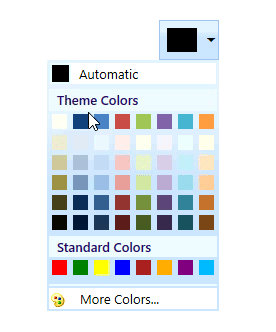
Expanded mode
If you want to directly use the palette without drop down button, set the Mode property value as Palette.
<syncfusion:ColorPickerPalette Mode="Palette"
Name="colorPickerPalette"/>ColorPickerPalette colorPickerPalette = new ColorPickerPalette();
colorPickerPalette.Mode = PickerMode.Palette;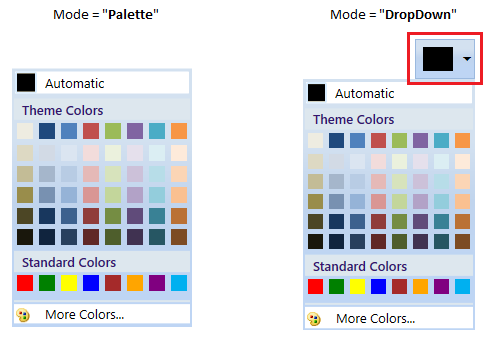
NOTE
View Sample in GitHub
ColorPickerPalette as a command button
By default, ColorPickerPalette acts like a dropdown. It opening a color palette when clicking anywhere on the header. By setting the Mode property to Split, it acts like a button and dropdown as explained below.
- When clicking on the dropdown arrow button, It acts like a dropdown.
- When you click on the header area, it acts like a button and SelectedCommand will be triggered. Using this command, you can do some action like applying the selected color as background of selected text.

For example, if you want to apply a last selected color as a foreground to a TextEditor’s selected text. You can direct click the button instead of opening the dropdown and selecting an already selected color again.
//ViewModel.cs
public class ViewModel : NotificationObject
{
private ICommand selectionChangedCommand;
private ICommand loadedChangedCommand;
private RichTextBox TextBox;
public ICommand SelectionChangedCommand {
get {
return selectionChangedCommand;
}
}
public ICommand LoadedChangedCommand {
get {
return loadedChangedCommand;
}
}
public void Loadedmethod(object param) {
TextBox = param as RichTextBox;
}
public void PropertyChangedHandler(object param) {
if (param != null && TextBox != null) {
ColorSelectedCommandArgs groupItem = param as ColorSelectedCommandArgs;
TextRange range = new TextRange(TextBox.Selection.Start, TextBox.Selection.End);
range.ApplyPropertyValue(FlowDocument.ForegroundProperty, groupItem.Brush);
}
}
public ViewModel() {
selectionChangedCommand = new DelegateCommand<object>(PropertyChangedHandler);
loadedChangedCommand = new DelegateCommand<object>(Loadedmethod);
}
}<syncfusion:ColorPickerPalette Name="colorpickerpalette"
Mode="Split"
SelectedCommand="{Binding SelectionChangedCommand}"
Width="60"
Height="40">
</syncfusion:ColorPickerPalette>
<RichTextBox Name="richTextBox"
Height="297"
Width="331">
<i:Interaction.Triggers>
<i:EventTrigger EventName="Loaded">
<i:InvokeCommandAction Command="{Binding LoadedChangedCommand}"
CommandParameter="{Binding ElementName=richTextBox}"/>
</i:EventTrigger>
</i:Interaction.Triggers>
<FlowDocument>
<Paragraph FontSize="14">Hello, world!</Paragraph>
<Paragraph FontStyle="Italic"
TextAlignment="Left"
FontSize="14">Thanks to the RichTextBox control,
this FlowDocument is completely editable!</Paragraph>
</FlowDocument>
</RichTextBox>colorPickerPalette.Mode = PickerMode.Split;
NOTE
View Sample in GitHub
Change color item size
We can change each color item size by using the BorderWidth and BorderHeight properties. Based on the color items size, the color palette is resized. The default value of BorderWidth and BorderHeight properties is 17.
<syncfusion:ColorPickerPalette BorderWidth="30"
BorderHeight="30"
Name="colorPickerPalette"
Width="60"
Height="40">
</syncfusion:ColorPickerPalette>ColorPickerPalette colorPickerPalette = new ColorPickerPalette();
colorPickerPalette.BorderWidth = 30;
colorPickerPalette.BorderHeight = 30;
colorPickerPalette.Width = 60;
colorPickerPalette.Height = 40;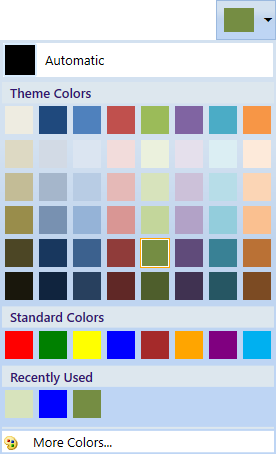
Change color palette size
We can change the color palette pop size by using the PopupWidth and PopupHeight properties. Based on the popup color palette size, the color items are resized. The default value of PopupWidth and PopupHeight properties is 175 and 200.
<syncfusion:ColorPickerPalette PopupWidth="120"
PopupHeight="100"
Name="colorPickerPalette"
Width="60"
Height="40">
</syncfusion:ColorPickerPalette>ColorPickerPalette colorPickerPalette = new ColorPickerPalette();
colorPickerPalette.PopupWidth = 120;
colorPickerPalette.PopupHeight = 100;
colorPickerPalette.Width = 60;
colorPickerPalette.Height = 40;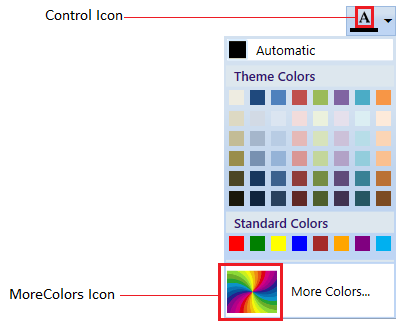
NOTE
If we use both
PopupWidth&PopupHeightandBorderWidth&BorderHeight, thenBorderWidth&BorderHeightproperties have higher priority.
Change header and more color icons
We can set the icons for control header which is placed left to the DropDown button and more color panel header by using the Icon and MoreColorsIcon properties. We can change the icon size for the control icon and more color icon by using the IconSize and MoreColorsIconSize properties.
<syncfusion:ColorPickerPalette Icon="/Label.png"
IconSize="18,18"
MoreColorsIcon="/MoreColor.png"
MoreColorsIconSize="50,50"
Name="colorPickerPalette"
Width="60"
Height="40">
</syncfusion:ColorPickerPalette>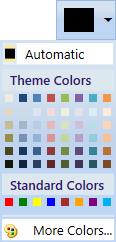
Click here to download the sample that showcases features and different type color items with its panel visibility customization.
Hide the drop down button
You can hide the dropdown button in the ColorPickerPalette by setting the dropdown button visibility as Collapsed. You can open a popup color palette by clicking the header of the ColorPickerPalette.
<syncfusion:ColorPickerPalette Loaded="ColorPickerPalette_Loaded"
Name="colorPickerPalette"/>ColorPickerPalette colorPickerPalette = new ColorPickerPalette();
colorPickerPalette.Loaded += ColorPickerPalette_Loaded;private void ColorPickerPalette_Loaded(object sender, RoutedEventArgs e) {
var dropDown = (Border)(sender as ColorPickerPalette).Template.FindName("UpDownBorder", colorPickerPalette);
if (dropDown != null) {
dropDown.Visibility = Visibility.Collapsed;
}
}